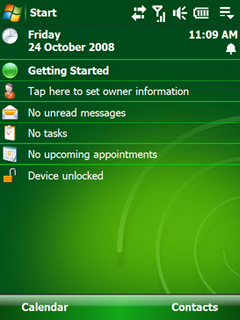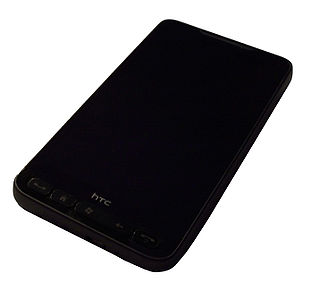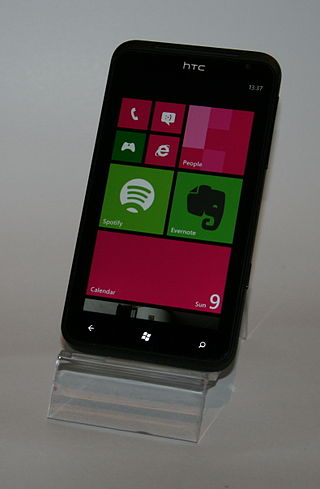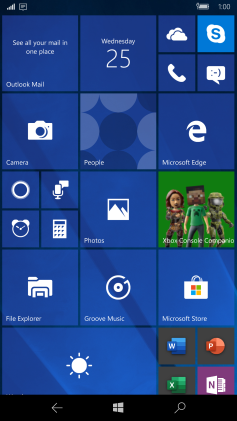
A Pocket PC is a class of personal digital assistant (PDA) that runs the Windows Mobile or Windows Embedded Compact operating system that has some of the abilities of modern desktop PCs. The name was introduced by Microsoft in 2000 as a rebranding of the Palm-size PC category. Some of these devices also had integrated phone and data capabilities, which were called Pocket PC Phone Edition. Windows "Smartphone" is another Windows CE based platform for non-touch flip phones or dumber phones.

Windows Mobile was a mobile operating system developed by Microsoft for smartphones and personal digital assistants.

HTC Corporation, or High Tech Computer Corporation, is a Taiwanese consumer electronics corporation headquartered in Xindian District, New Taipei City, Taiwan. Founded in 1997, HTC began as an original design manufacturer and original equipment manufacturer that designed and manufactured laptop computers.

Internet Explorer Mobile was a mobile version of Internet Explorer developed by Microsoft, based on versions of the MSHTML (Trident) layout engine. IE Mobile comes loaded by default with Windows Phone and Windows CE. Later versions of Internet Explorer Mobile are based on the desktop version of Internet Explorer. Older versions however, called Pocket Internet Explorer, are not based on the same layout engine.

The HTC TyTN is an Internet-enabled Windows Mobile Pocket PC PDA designed and marketed by High Tech Computer Corporation of Taiwan. It has a touchscreen with a left-side slide-out QWERTY keyboard. The TyTN's functions include those of a camera phone and a portable media player in addition to text messaging and multimedia messaging. It also offers Internet services such as e-mail, instant messaging, web browsing, and local Wi-Fi connectivity. It is a quad-band GSM phone with GPRS, and EDGE, and a single/dual band UMTS phone with HSDPA. It is a part of the first line of PDAs directly marketed and sold by HTC. On AT&T/Cingular, the TyTN was the successor to the HTC Wizard, known as the Cingular 8125. Also on AT&T, the TyTN was superseded by the HTC TyTN II, known as the AT&T 8925 and the AT&T Tilt.

Windows Mobile 6, formerly codenamed "Crossbow", is a version of Windows Mobile released on February 12, 2007 at the 3GSM World Congress 2007. It comes in three different versions: "Windows Mobile 6 Standard" for Smartphones, "Windows Mobile 6 Professional" for Pocket PCs with phone functionality, and "Windows Mobile 6 Classic" for Pocket PCs without cellular radios.
A mobile operating system is an operating system used for smartphones, tablets, smartwatches, smartglasses, or other non-laptop personal mobile computing devices. While computers such as typical/mobile laptops are "mobile", the operating systems used on them are generally not considered mobile, as they were originally designed for desktop computers that historically did not have or need specific mobile features. This line distinguishing mobile and other forms has become blurred in recent years, due to the fact that newer devices have become smaller and more mobile unlike hardware of the past. Key notabilities blurring this line are the introduction of tablet computers, light laptops, and the hybridization of the two in 2-in-1 PCs.

Windows Phone (WP) is a discontinued mobile operating system developed by Microsoft for smartphones as the replacement successor to Windows Mobile and Zune. Windows Phone featured a new user interface derived from the Metro design language. Unlike Windows Mobile, it was primarily aimed at the consumer market rather than the enterprise market.

Windows Mobile 6.1 is a version of the Windows Mobile operating system, released on April 1, 2008. It is a minor upgrade to the Windows Mobile 6 platform with various performance enhancements and a redesigned Home screen featuring horizontal tiles that expand on clicking to display more information, although this new home screen is featured only on Windows Mobile Standard edition. This was not supported in the Professional edition. Several other changes such as threaded SMS, full page zooming in Internet Explorer and 'Domain Enroll' were also added, along with a "mobile" version of the Microsoft OneNote program and an interactive "Getting Started" wizard. Domain Enroll is functionality to connect the device to System Center Mobile Device Manager 2008, a product to manage mobile devices. The most apparent of the other differences is that the Standard version still creates automatic links for telephone numbers in Tasks and Appointments, which allows for the easier click and dial of stored telephone numbers within these Outlook items. This feature is not supported in the Professional version. Windows Mobile 6.1 also had improved bandwidth efficiency in its push-email protocol "Activesync" of "up to 40.02%"; this considerably improved battery life in many devices.

TouchFLO 3D is a graphical user interface designed by HTC. It is used in the HTC Touch Family of Pocket PCs and was preceded by TouchFLO. TouchFLO 3D has been ported to Windows Mobile and Android, and is used in the HTC Touch Diamond, HTC Touch Pro, HTC Touch HD, HTC MAX 4G, HTC Touch Diamond2 and HTC Touch Pro2. The HTC Touch Viva, HTC Touch 3G and HTC Touch2 have a simpler version entitled TouchFLO 2D, where they have the same scrolling tab on the bottom of the screen, however they do not have any 3D visual effects. From the HTC Hero and HTC HD2 onwards, TouchFLO 3D has been heavily extended and is now being referred to, along with other usability improvements, as HTC Sense. The HTC Touch2 runs a version of TouchFLO 2D that is similar in style to HTC Sense.
The HTC Touch family was a family of Pocket PCs designed and manufactured by HTC Corporation. Its slogan was Discover Touchnology.

The HTC Touch Diamond2, a mobile phone designed by the HTC Corporation, is the successor to the popular HTC Touch Diamond. It is also known by its codename, the HTC Topaz. It is released with Microsoft Windows Mobile 6.1, but can be upgraded to Windows Mobile 6.5. It is the first device to feature a revamped version of HTC's TouchFLO 3D GUI, an interface first seen on its predecessor. The Touch Diamond2 has been announced to be released in Q2 2009 and was first announced at the Mobile World Congress 2009 in Barcelona.

The HTC HD2, is a smartphone in the HTC Touch family designed and manufactured by HTC. The HD2 natively runs the Windows Mobile 6.5 operating system, and was released in Europe in November 2009, in Hong Kong in December 2009, and in other regions including North America in March 2010. The phone is the successor to the HTC Touch HD, and is succeeded by the HTC HD7.

The HTC Evo 4G is a smartphone developed by HTC Corporation and marketed as Sprint's flagship Android smartphone, running on its WiMAX network. The smartphone was launched on June 4, 2010. It was the first 4G enabled smartphone released in the United States.

The HTC HD7, is a smartphone running the Windows Phone OS operating system. The phone was designed and manufactured by HTC. It is the successor to the HTC HD2, and it has a special variant which is the HTC HD7S.

The HTC Trophy is one of several Windows Phone handsets produced by HTC Corporation.
This page provides details for the version history of the Microsoft's Windows Phone branded mobile operating systems, from the release of Windows Phone 7 in October 2010, which was preceded by Windows Mobile version 6.x.

Nokia Lumia 610 is a Windows Phone smartphone announced at Mobile World Congress 2012. It is designed for young consumers that are buying their first smartphone. The Lumia 610 has a curvy, metallic design. Like the Lumia 710, it comes in cyan, magenta, black and white. The black and magenta version have a rubberized back instead of the glossy back as found in the white and cyan version of this phone.

Windows Phone 7 is the first release of the Windows Phone mobile client operating system, released worldwide on October 21, 2010, and in the United States on November 8, 2010. It runs on the Windows CE 6.0 kernel.

Windows 10 Mobile is a discontinued mobile operating system developed by Microsoft. First released in 2015, it is a successor to Windows Phone 8.1, but was marketed by Microsoft as being an edition of its PC operating system Windows 10.














